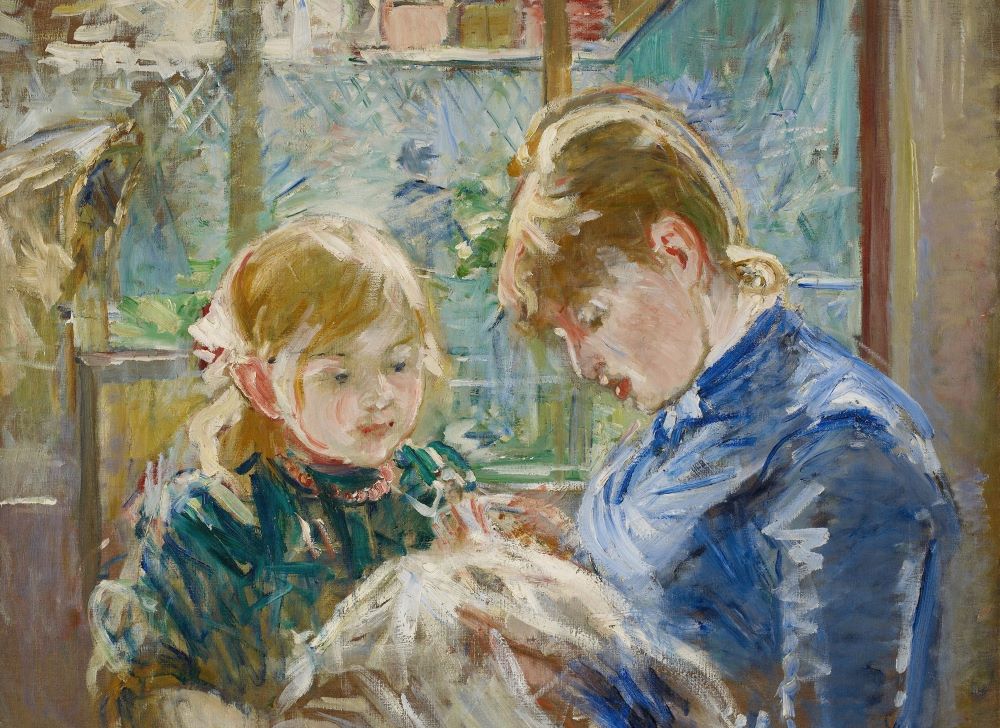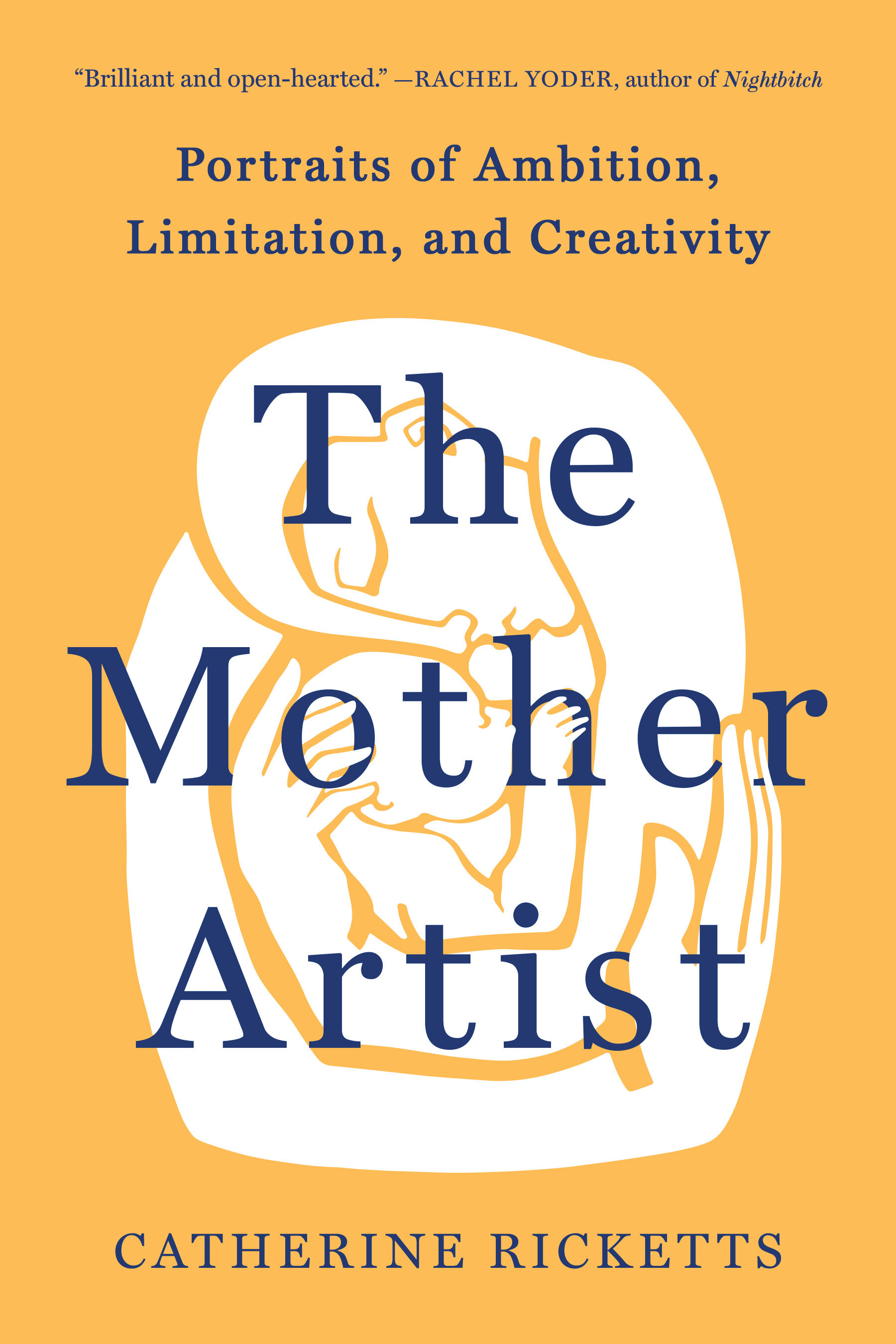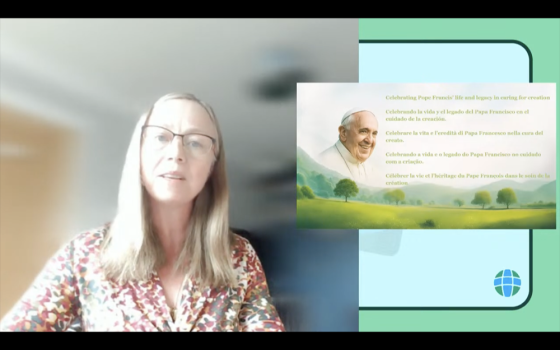
"The Artist's Daughter, Julie, with her Nanny" (circa 1884) by the French Impressionist painter Berthe Morisot (1841-1895) (Artvee)
Over the last seven years of living with disability and illness, the peers I've related to most as an artist with profound limitations have been mothers. The mother of five who furiously types away at short stories late at night because this is the only time she can find a moment's peace and quiet. The mother who thinks she should write, even wants to write, but finds herself drawn away from the page by household chores and the small, perfect pleasure of listening to her little girls' chatter. The mother who balances art and child care and chronic illness all at once. I relate to these mothers who are also artists because of the ways their bodies — and the care of their children’s bodies — limits them, just as my sick body limits me.

When my pain keeps me bedridden and disability forces me to take days, weeks, even months off at a time; when the public-facing world of the artist leaves little space for vulnerable persons; it’s the mothers — those who know in their bodies what it's like to create while feeling depleted — who most often understand.
Which is one of many reasons why, despite not yet being a mother myself, I am grateful for Catherine Ricketts' debut book, The Mother Artist: Portraits of Ambition, Limitation, and Creativity. Part memoir, part study of historically recent and contemporary artists, this slim book is a gentle, thorough excavation of the many questions, frustrations and, ultimately, gifts of a culture that welcomes mothers who make art.
The book is lean, yet Ricketts manages to touch on a wide berth of subjects pertaining to motherhood. Sex. Pregnancy. Labor. Infancy. Breastfeeding. Miscarriage. Weaning. All the embodied-ness of motherhood is here. There's a diversity of artists as well, including painters, writers, photographers, vocalists. Ricketts takes care to broaden her lens outside her white perspective, profiling artists from different viewpoints than her own, such as the Black painter and printmaker LaToya Hobbs and the Filipino mother-daughter dance choreographers Anito and Malaya Gavino of Ani/MalayaWorks. Readers will recognize household names such as Joan Didion, Marilynne Robinson, Toni Morrison and Greta Gerwig, but no doubt discover new artists to follow. As I read, I found myself googling many of the artists Ricketts writes about, flipping through art on Instagram and saving books I hope to read in the future.
'Is it that mothers aren't making art, or that they lack access to institutions with the power to fund and champion their work?'
—Catherine Ricketts
At the beginning of the book, Ricketts, who at the time worked as a performance planner at the Philadelphia Museum of Art, wanders through the galleries in search of mother artists. She misses her son, her first baby, whom she recently left at home after breastfeeding. She goes in search of mothers because she wants their soothing company, but finds very few on the museum walls. Why, Ricketts asks, is this? Where are the mothers?
Ricketts asks more questions than she answers; and with her gentle, leading questions, she encourages us to interrogate our assumptions about motherhood and art.
"Is it that mothers aren't making art, or that they lack access to institutions with the power to fund and champion their work?" she asks. The answer isn't straightforward, and perhaps one of her goals is to show us the mothers who do make art. Bringing them into our vision, she makes us realize how difficult it is for them to devote creative energy and time to making things that may never pay financially in return — and that they do so anyway.
Another goal: to show the importance of art made by mothers for our culture. When mothers are pushed out of the artmaking world, it's not just the mother artists who miss out, but all of us who need the mother artist's maternal vision. In a world wrecked by ailments of all kinds (Ricketts wrote part of the book during the pandemic, with protests for racial justice happening blocks from her apartment), Ricketts calls for a revolution of tenderness that mother artists, whose care for their own children can extend to every person in the world, are particularly equipped to offer.
"I want to live in a world humanized by maternal vision," she writes. This belief in what the maternal vision can offer the world motivates Ricketts to find ways to balance and integrate her own work as a writer with her role as a caregiver. Each of the artists Ricketts profiles models ways to cultivate this maternal vision, such as Toni Morrison, who as a rule worked with the door to her home office left open. Ricketts suggests this open door signaled both Morrison's attentiveness to the needs of her family, as well as how interruptions by her needy children kept her soft and grounded, in touch with human dependence and love.
Advertisement
There is very little interaction with the Christian faith in these pages — a short but beautiful interaction with a nun, a bit about the Christian theologian Natalie Carnes, author of Motherhood: A Confession and a reference to the Pietá. Readers who think of motherhood as vocation, and who wonder how artistic ambition fits within the Christian virtue of humility, might wish Ricketts had addressed what motherhood and artmaking mean in light of faith.
Then again, perhaps Ricketts has done us a favor by extracting the idea of motherhood from the religious baggage surrounding what a mother is "supposed to be." Mostly, Ricketts seems to want us to come away realizing that motherhood is a topic worthy of artistic exploration. "Motherhood is so ordinary that we have trouble seeing all that is extraordinary about it. It is, as the design critic Alexandra Lange says, 'obscured by its own ubiquity' — too normal for us to notice." Ricketts wants to change that.
As I write this review, my fingers have begun to hurt a little, and I know I will need to switch to my voice transcription software if I want to keep writing. This is my limitation, caused by my disability, and it is qualifiedly different from the limitations my friends who are mothers face. And yet, I think they would understand that my limited capacity in some way humanizes my work. I may not have the joy of a tiny baby to show for it, but my empathy is stretched, and I am seen best by my friends who are mother artists because their maternal vision extends to me.
In this way, The Mother Artist is profoundly human, because all of us have been small, helpless babies in the past, and all of us will face profound limitations at some point in the future. This is a book not just for mother artists, but artists who hope to be mothers, partners of mother artists, artists like myself who struggle with disability — the maternal vision is good and vast. It's a hard-won gift born of sacrifice and love, meant for us all.







